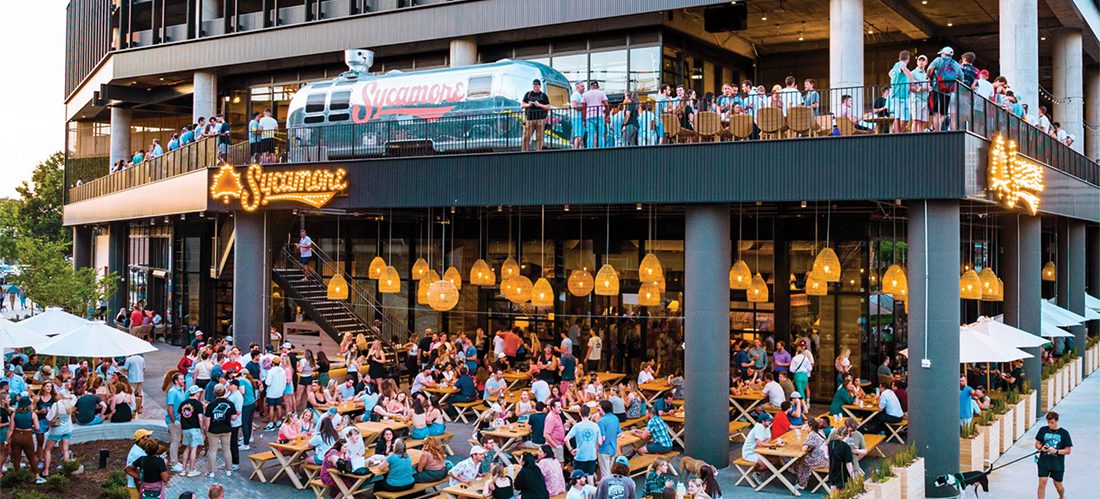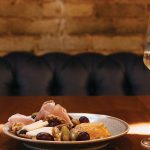The art of expansion in Charlotte’s craft brew scene
September 28, 2023

With revamped taprooms, out-of-town breweries moving in, and beloved local brands spreading across the city, Charlotte’s craft-beer culture is ever-evolving — yet remains strong as ever.
by Liz Logan
Red neon lights shroud the taproom, the glow gleaming from above and reflecting off the slick concrete floor below. A life-size Ichabod Crane-esque figure sits atop a motorcycle suspended in midair. Through chain curtains theatrically pulled aside is a decidedly more feminine space, outfitted with draping ivy, towering snake plants and pastel chairs dotting dining tables offset by a botanical mural still true to the multifaceted brand. Resident Culture Brewing Co.’s satellite South End location is a seamless juxtaposition of styles, not unlike that of its beer portfolio.
The South End location opened in 2022, but Resident Culture has been a Charlotte brewery staple since the 2017 opening of its flagship Plaza Midwood location. With all the breweries opening around the city, co-founders Amanda and Phillip McLamb and Chris Tropeano have an obvious handle on what it takes to build a desirable brand in an expanding market, and that’s to create spaces and products that will keep people coming back. “Gone are the days where you could just open a brewery, throw up some picnic tables, have live music and be packed out all the time,” says Phillip McLamb, Resident Culture’s chief operating officer.
A SWIFT EVOLUTION
The beer scene has undergone a quick and substantial shift, with Charlotte seeing its fair share of brewery iterations over the years. A little more than a decade ago, the city was slowly cutting its teeth on craft beer. After a few rounds of brewery openings and closings, in the early 2010s only two breweries called the city home: Four Friends Brewing, which shuttered in 2014, and The Olde Mecklenburg Brewery. Charlotte’s longest-standing brewery opened its doors in 2009 and serves some of Charlotte’s most quintessential beers — OMB’s Copper, an amber ale, and Captain Jack, a German-style pilsner, are mainstays on Queen City menus.
Taprooms weren’t fanciful — the main craft and artistry showcased was the beer itself. Walls were often adorned with rotating statement pieces from local artists, accompanied by modest seating, creating an approachable communal space for those searching for something outside the typical bar and brewpub scene. A love for brews outside of easy-drinking domestics beckoned a crowd of budding connoisseurs eager to discuss hop varietals and yeast strains alongside their fellow “beer nerds,” a niche audience finally finding its footing.
Until the mid 2010s, the beer scene had been a (mostly) boys club of sorts, guys who discussed beer science at homebrew clubs sprinkled throughout the city at places like The Flying Saucer and The Pizza Peel. From such social gatherings, Todd and Suzie Ford were inspired to take their homebrew recipes, alongside fellow homebrewer Chad Henderson, and launch NoDa Brewing in 2011.



Beyond beer cheese and pretzels: Ahi tuna nachos and tacos, grass-fed beef burgers, and salads highlighting local farms and food purveyors are on the menu at Suffolk Punch SouthPark, top right photo. Some breweries, such as Trolley Barn Fermentory and Food Hall, bottom right, are becoming all-day cafes, with coffee, breakfast and lunch on the menu. Left and top photos by Justin Driscoll; bottom right courtesy Legion Brewing
Today, more than 100 breweries call Charlotte and the surrounding area home. It’s no secret that the 2007 implementation of the LYNX Blue Line shaped much of Charlotte’s industrial overhaul. As with many businesses and industries, as stops were added, so were breweries. In South End, Suffolk Punch and Sycamore Brewing entered the fold. Lower South End would be colloquially rebranded to LoSo, in part due to its evolution as a craft-beer destination, NoDa would follow suit, with nanobreweries and larger operations now in its midst. Atherton Mill’s Trolley Barn Fermentory, a part of the Legion Brewing empire, and Wooden Robot’s NoDa location, The Chamber, offer rooftop views, each situated just steps from light rail stations.
Since their inception, many of Charlotte’s longtime breweries have expanded: OMB, NoDa, Suffolk Punch and Legion are just a handful boasting multiple locations around the city, with more planned. And along with the expansion of homegrown breweries, plenty of out-of-towners (and in the case of Gilde Brewery, out-of-country-ers) have opened satellite taprooms, from Asheville’s Burial Beer and Hi-Wire Brewing to Atlanta’s Weathered Souls and Monday Night Brewing.
BEAUTY IN THE BOOM
Naturally, there is the argument that the Queen City has become inundated with breweries, with the constant reports of openings (and the occasional closing) eliciting eye rolls and contentious comments on social media. And nationwide, the overall craft-beer market is declining slightly, according to statistics from the Brewers Association trade group.
So what’s different about Charlotte?
As far as McLamb is concerned, the post-Covid establishment of out-of-towner breweries in Charlotte does wonders for the local industry and cements the city’s reputation as a desirable craft-beer destination. This designation has given Resident Culture confidence in expanding its market presence. In August, the brewery debuted its third location at uptown’s The Market at 7th Street, adding to the list of light rail-accessible craft breweries. Setting up in the former Tank’s Taps stall already upfitted for draft pours, McLamb says the space will allow new customers to be introduced to their robust tap list.
One of the organic components in the cultivation of Charlotte’s brewery culture — in its infancy when compared with more established craft-beer hubs like Asheville and Denver, Colo. — is the camaraderie among breweries, and the idea that what’s good for the few can be good for the many. “It also keeps us on our toes to continue to innovate and create experiences for our customers that can compete with all the other great breweries out there,” McLamb adds.
What gets lost in the discourse, however, is the beauty of the boom. “From our point of view, quality comes in many shapes and sizes, be it quality of the liquids, quality of the brand, quality of the experience, quality of the people,” McLamb says. A higher caliber will ultimately keep the industry strong and bring about meaningful growth for not only brewing as a whole but the people behind the bar and in the brewhouse.


Left: Breweries like Sycamore in South End have become more design-centric than the bare-bones industrial-chic spaces of old. Right: More women are taking the reins at local breweries, including Erin Jordan, head brewer at Resident Culture. Photographs courtesy Sycamore Brewing and Resident Culture
A ‘BOYS CLUB’ NO MORE
With the shifts and growth over the last decade, many breweries have expanded to all-day affairs. Coffee, breakfast and lunch are offered during the day. Food menus, once limited to pretzels and nachos, now feature gourmet or chef-driven cuisine. Bar menus have expanded to include wine and cocktails.
In NoDa, Salud Cerveceria owner Dairelyn Glunt leads the wine lineup, with a focus on natural wines. While Salud has long been known for its bottle selection — the beer shop downstairs was named Best Beer Bar in the country by USA Today three years running and this year was nominated for a James Beard Award — it began brewing in 2017, opening doors for other options. “Beer can get kind of bro-y, and the wives wouldn’t come in,” Glunt explains. “Bringing in wine brings in a whole new crowd of men and women, giving a high-quality variety.”
Likewise, the stereotypically male-dominated breweries are seeing an influx of award-winning women taking the reins. Rachael Hudson leads the charge at Pilot Brewing, which has brought home countless medals from the U.S. Open Beer Championship and the Great American Beer Festival, the Oscars of craft beer. Erin Jordan, a former UNC Chapel Hill soccer player who was head brewer at Asheville’s Archetype Brewing before moving to Charlotte in 2021, was recently named Resident Culture’s head brewer.
The overall aesthetic is seeing an overhaul as well. Sycamore’s new two-story location has taken a sharp turn from the original red-brick warehouse-and-beer-garden look to embrace a more boho-meets-nostalgia vibe, with wicker light fixtures and the Airstream food truck as a focal point of the upstairs patio. Natural wood accents give an airy feel both indoors and out.
For those inclined to believe breweries have lost their beer-centric origins with the introduction of seltzers, wine and cocktails, and the focus on Instagrammable-interiors, what still exists for those running the boil kettles and bright tanks is the passion and artistry that started it all, arguably allowing for each of these expansions and newly opened breweries. In a city of creatives, a myriad of artists — from brewers to muralists to interior designers — has found a home in every facet of the beer industry and, thankfully, it doesn’t seem to be slowing down any time soon. SP
CHEERS: Charlotte Craft Beer Week takes place Friday, Oct. 20, through Sunday, Oct. 29, with more than three dozen breweries, cideries and taprooms participating. Events include neighborhood brewery crawls, collab releases, a home brew competition and more.
Feature photograph by Matt Ray, courtesy Sycamore Brewing

